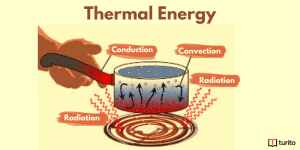Kinetic Energy
Everyone knows the reason we eat food is to get energy or to build our stamina. It helps all living beings to perform several basic activities to survive. Humans need energy to perform various other activities like singing, playing, running, writing, jumping, thinking, etc.
These all forms of work require different types of energy. Can you guess these forms according to the work performance? Can you tell what type of energy roller coaster cars possess to move? What type of energy is needed to move or carry heavy loads?
Well, these all tasks are performed because of kinetic energy. What is kinetic energy? What is its definition? And how do you calculate it? These questions are all answered in this article. To understand the term ‘kinetic energy,’ read this article.
What is Kinetic Energy?
The term ‘kinetic energy’ sometimes sounds like a complicated term. But in actuality, it is a simple term. There are various types of energy, i.e., mechanical energy, chemical energy, electrical energy, nuclear energy, elastic energy, gravitational energy, radiant energy, thermal energy, ionisation energy, etc.
A moving object can do work. The faster the body moves, the more work it performs rather than the identical slow object. Blowing wind, a speeding stone, a moving bullet, or a rotating wheel can do work. Every object that is in motion acquires some energy. And this energy is known as kinetic energy.
Kinetic Energy Definition
This energy is one of the two main forms of energy, which is stored within the objects during their rest. The main characteristics of this energy are moving objects and movement. It only presents in those objects that are in motion.
This energy is a scalar quantity and one of the different forms of energy. As per kinetic energy definition, it is the energy of a body during its motion, which means it is vital for all moving bodies. A falling coconut, a rolling stone, a speeding car, flowing water, a flying aircraft, blowing wind, a running athlete, etc., all possess kinetic energy.
When any object releases potential energy, it gives birth to kinetic energy. Kinetic energy, together with potential energy, forms mechanical energy. Thermal energy or heat energy is also kinetic.
Kinetic Energy Formula
In Physics, the kinetic energy of a non-rotating rigid body or a point object depends on the object’s mass and speed. It is half the product of the mass and square of the speed.
Mathematically,
K.E. = (½) mv2
Here, K.E. = Kinetic energy, m = mass of the object, and v = speed of the object.
The S.I. units of mass and velocity are kg and m/sec. Hence, for kinetic energy, the S.I. is similar to that of work, i.e., Joule (J).
In the case of electrical objects, kinetic energy is measured in kWh, which is also the measurement unit of electricity in households.
Examples of Kinetic Energy
You can best understand kinetic energy with the help of real-time examples. Anything you have that has moved or can move is an example of kinetic energy. Some of them are
- This energy helps a cyclist move the cycle from one position to another. In this process, the chemical energy he gets from food is converted into kinetic energy in moving it.
- Riding a car from mountain to valley.
- Rolling dice or cube while playing ludo.
- Kicking the football, spinning the cricket ball, rolling the cue ball on the billiard table.
- Breaking the window glasses or breaking the piles of tiles during karate competition.
- Circulating a fan on warm days, dancing, or skydiving.
- Running, jogging or warming up the body during exercise or before playing any sport.
- Any actively moving object in the world is an example of kinetic energy.
Different Forms of Kinetic Energy
There are different forms of energy that are classified under kinetic energy. Objects in motion due to rotation, vibration, or translation are classified under the kinetic form of energy.
1. Rotational Kinetic Energy:
When an object moves around its axis, the energy it possesses is known as rotational kinetic energy. This energy depends on certain factors like how much the object weighs, how fast it is spinning, or the location of the centre of mass along the axis.
Flying wheels, molecules, turbines, planets, etc., revolve along the axis. And hence, they hold rotational kinetic energy.
2. Translational Kinetic Energy:
It is formed whenever two or more objects strike each other. The main characteristic of translational kinetic energy is that it only forms when all the particle molecules should be moving in the same direction under the influence of the same force.
A golf club striking a golf ball is an example of translational kinetic energy. This form of kinetic energy depends on the motion through space only.
3. Vibrational Kinetic Energy:
Whenever there is vibration in the object, its molecules possess vibrational kinetic energy. In other words, this energy is due to the vibrational motion of the object. Vibrating smartphones, the sound coming from the drum, vibration in doors or window doors due to loud music, etc., are some examples of vibrational kinetic energy.
Factors Affecting Kinetic Energy
Kinetic energy is the half product of the object’s mass and square of its speed. Hence, two factors affect the kinetic energy, i.e., the object’s mass and speed.
K.E. = (½) mv2
- It is directly proportional to mass, i.e., K.E. ∝ m. Therefore, if there is an increase in the object’s mass, the kinetic energy will also increase.
- This energy is directly proportional to the square of the velocity or speed of the object. It means an increase in velocity results in an increase in the object’s kinetic energy.
Although the object’s mass affects the object’s kinetic energy, velocity is an important factor. It is because if you double the object’s mass, then it will double the kinetic energy. At the same time, if you double the object’s speed, then the kinetic energy will quadruple its amount.
Some Solved Problems of Kinetic Energy
Example 1. How fast should a man of 50 kg run, so his kinetic energy is 625 J?
Answer: Here, the mass of the person, m = 50 kg
The kinetic energy of the man, K.E. = 625 J
According to the kinetic energy formula,
K.E. = (½) mv2
v2= (2 x K.E.)/m
v = √[(2 x K.E.)/m]
v = √[(2 x 625)/50]
v = 5 m/sec
Hence, the speed of the man is 5m/sec.
Example 2. Calculate the kinetic energy of a body with a mass of 1kg and moving at a speed of 2m/sec.
Answer: Here, the mass of the body, m = 1kg
Speed of the body = 2m/sec
According to the kinetic energy formula,
K.E. = (½) mv2
K.E. = (½) x 1 x (2)2
K.E. = 2J
Hence, the kinetic energy of the body is 2J.
Example 3. A ball falls from a height of 5m and has a mass of 200 g. What will be its kinetic energy when the ball just reaches the ground? (Given: g = 9.8 m/sec2)
Answer: Here, the mass of the ball, m = 0.2 kg
Height from which the ball dropped, h = 5m
Acceleration due to gravity, g = 9.8 m/sec2
Initial velocity of the ball, u = 0m/sec
Now, according to the third law of motion,
v2= u2 + 2as
v2 = 0 + (2 x 9.8 x 5) = 98
Now, according to the kinetic energy formula,
K.E. = (½) mv2
K.E. = (½) x 0.2 x 98 = 9.8
Hence, when the ball reaches the ground, the kinetic energy is 9.8 J.
Conclusion
Energy and work are correlated terms. The energy of a body is its capacity to do work. It is found in many things and exists in many different forms. Kinetic energy is one of the various forms of energy. A moving object possesses it by the effect of its motion. It is even required for the evolution of all forms of life on the earth.
The law of conservation of energy states that energy transforms from one form to another during the change in the system, i.e., it can neither be created nor destroyed. This law applies to kinetic energy. You can change kinetic energy into potential energy and vice-versa.
Frequently Asked Questions
1. How does the kinetic energy of a moving body depend on its speed and mass?
The kinetic energy of a moving body depend on its speed and mass because
- This energy of a movable object is directly proportional to the square of the object’s speed.
- This energy of a mobile object is directly proportional to the mass of the object.
2. A body is thrown by raising in an upward direction. Its velocity continuously decreases. What transpires to its kinetic energy so that its velocity becomes zero?
When an object is thrown vertically upwards against the force of gravity, its kinetic energy decreases as its velocity decreases. When height reaches the maximum limit, kinetic energy becomes zero as the object’s velocity becomes zero. At the maximum height, the object’s kinetic energy is completely transformed into potential energy.
3. What are the differences between kinetic energy and potential energy?
| Potential Energy | Kinetic Energy |
| It is independent of the speed of the object. | It is the energy of an object that leads to the change in its shape, configuration, or size. |
| It is directly proportional to the square of the speed of the moving object. | It is the energy of an object by the effect of its motion. |

Relevant Articles
Understanding Thermal Energy: What It Is and How It Works
Thermal energy is essential to our daily lives, from warming …
Understanding Thermal Energy: What It Is and How It Works Read More »
Read More >>Avogadro’s Number: Meaning, Importance, and More
Introduction The concept of measuring the microscopic particles that make …
Avogadro’s Number: Meaning, Importance, and More Read More »
Read More >>Kinetic Friction – Definition, Laws, Types
Kinetic Friction Kinetic force is a force acting between two …
Kinetic Friction – Definition, Laws, Types Read More »
Read More >>




















Comments: